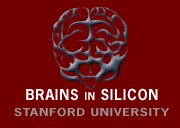Anand Chandrasekaran Development: Axon guidance
|
 |
|||
The sensory world is organized into regular neuronal arrays or maps. The most common example being maps of visual space in regions such as the visual cortex and the superior colliculus. In these maps, neighboring cells respond to similar features of sensory stimuli, and there is an orderly progression of these features across the array of neurons. While genes provide an instructive signal that sets up the gross topographic connectivity between brain regions (For review see McLaughlin 2005), activity-dependent instructive signals, provided by either the environment, or by patterned spontaneous activity early in development, control specificity or refinement (Chandrasekaran 2005, 2007, 2009). Through this activity-dependent process, afferent projections come to accurately reflect patterns of sensory input. One major aspect of this refinement or learning process involves the organization of axon arbors. The dynamics of synapse formation and stabilization have been strongly linked with the growth, branching and pruning of axons (Meyer 2006, Ruthazer 2006), possibly a function of target derived neurotrophic factors (Marshak 2007, Hu 2005). This leaves us with a novel synapse-based axon-routing scheme that I intend to implement in silicon. Key components of the Axon Router Chip are ready and the chip is being assembled for fabrication (as of Feb 2009).
References McLaughlin T, O'Leary DD, Molecular gradients and development of retinotopic maps, Annu Rev Neurosci. 2005;28:327-55. Meyer MP, Smith SJ, Evidence from in vivo imaging that synaptogenesis guides the growth and branching of axonal arbors by two distinct mechanisms, J Neurosci. 2006 Mar 29;26(13):3604-14. Ruthazer ES, Li J, Cline HT, Stabilization of axon branch dynamics by synaptic maturation, J Neurosci. 2006 Mar 29;26(13):3594-603. Hu B, Nikolakopoulou AM, Cohen-Cory S, BDNF stabilizes synapses and maintains the structural complexity of optic axons in vivo, Development. 2005 Oct;132(19):4285-98. Marshak S, Nikolakopoulou AM, Dirks R, Martens GJ, Cohen-Cory S, Cell-autonomous TrkB signaling in presynaptic retinal ganglion cells mediates axon arbor growth and synapse maturation during the establishment of retinotectal synaptic connectivity, J Neurosci. 2007 Mar 7;27(10):2444-56.
|

